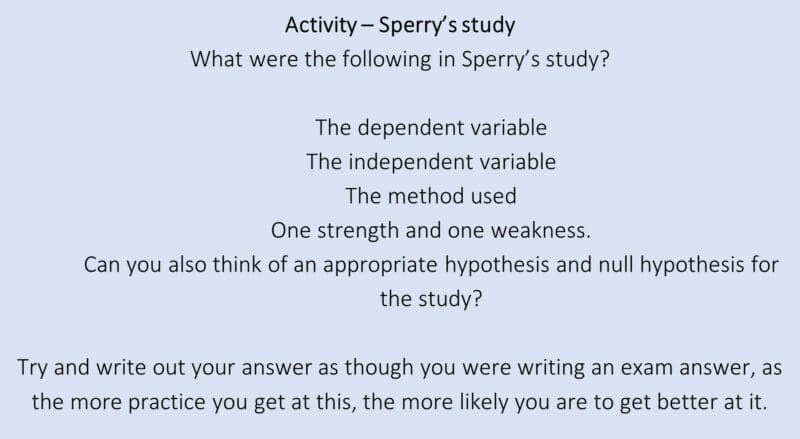In this post
As we have seen throughout this unit, the different hemispheres of the brain appear to be responsible for different functions and this is known as lateralisation. The hemispheres are divided by the corpus callosum, which plays an important part in ensuring that messages are successfully transmitted between each one.
Roger Sperry was interested in finding out what the differences are between the two hemispheres of the human brain and was able to study individuals who experienced something known as ‘hemisphere deconnection’ where messages could not be successfully transmitted between the two hemispheres.
Aim
Sperry aimed to investigate the effects of hemisphere deconnection and to show that each hemisphere has different functions.
Method
- This was a natural experiment as all variables occurred without Sperry’s intervention. He also used the case study method as he wrote extensively about his findings with each participant
- The participants were 11 ‘split-brain’ patients, that is, they were patients who had undergone disconnection of their brain hemispheres
- All participants took part in several tasks and their results were compared to participants who were not ‘split-brain’
- The independent variable therefore was whether or not the participant was a split-brain patient and the dependent variable was their performance on the tasks
- One of the tasks was presenting a stimulus to one of the hands of a split-brain patient so they could not see the stimulus and then asking them to name it. If the stimulus is presented to the participant’s left hand the participant should not be able to name it because the senses of touch and language are dealt with by different hemispheres
- Other tasks involved testing visual and auditory abilities
Results
- When participants were presented with an image in one half of their visual field and then presented with the same image in the other half of the visual field they responded as if they had never seen the image before
- Objects put in the participants hand for identification by touch could be described or named in speech or writing if they were in the right hand but if placed in the left hand, the participant could either only make wild guesses or even appeared to be unaware that anything at all was present
- Sperry found that the hemisphere deconnection did not appear to affect the patients’ intelligence (as measured by an IQ test) or their personality. The effects of the surgery did seem to have affected the patients in that they had short-term memory deficits, limited concentration spans and orientation problems
Conclusion
Sperry concluded that the results show that his ideas about different hemispheres being responsible for different functions were validated. He also concluded that each hemisphere has its own memories, perceptions and experiences.
Strengths of the study
- Sperry used a case study and a natural experiment and therefore he was able to gain both quantitative and qualitative data
- His research has been very influential in inspiring further research in this area of neuropsychology, which is ongoing
Weakness of the study
- The sample size of 11 is very small and therefore not generalisable to a larger population
- All participants were given the same tasks even though they had differences in levels of hemisphere deconnection, which means that the results may have been affected by individual differences
- The case study method is open to researcher bias and Sperry may have manipulated his findings to match his hypothesis




